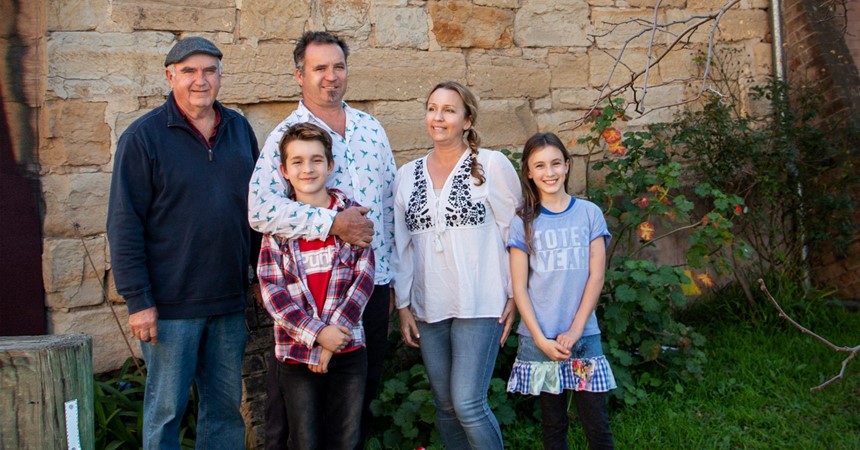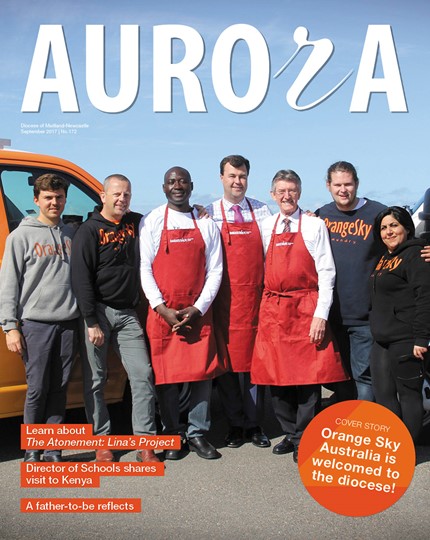I was aware it was the only surviving NSW site directly linked to Caroline Chisholm and had gazed lovingly at its humble, simple construction ‒ low, long verandah and sandstone walls book-ended by slightly less than vertical chimney stacks. I had also wondered about its earlier years around 1830 when its windows would have looked out on a very different scene ‒ bustling workers, noisy mills, solid banks, dusty roads. Close by was the convergence of horse and carriage tracks from Morpeth to Maitland and then southwards connecting with Wollombi and Sydney Cove, a route we now know as The Convict Road.
The row of five worker cottages had been built in present day East Maitland, where the people wanted to live ‒ centre stage where life was unfolding and thriving, close by the mighty Hunter River.
I asked the owner of 3 Mill Street, East Maitland, Angus Smith, how he came to purchase the cottage.
“I’m the proud great, great, great grandson of ‘Gentleman’ John Smith who in 1832, built the flour mill now fronting Newcastle Street, and the five adjoining cottages becoming known as Smith’s Row,” said Angus. “This one remaining cottage had been purposely converted for occupation as The Immigrants’ Home. When my father, Lindsay, and I saw this cottage for sale three years ago, we weren’t in a position to buy. Come this recent auction opportunity, our intention was clear ‒ let’s purchase!
Surrounded by supporters, wife Tobi, children Beau, Duke, Valli, Archer and father Lindsay, Angus talked of his busy landscaping business and his growing passion for stone masonry. “My vision is to restore the integrity of this building while acknowledging the original structure, replacing broken lintels, repairing the simple windows and preserving and reusing red cedar ceiling timbers where possible. Early external work to secure both chimneys is already completed with a structural necessity for one to remain at a rather jaunty angle – a visual reminder of yet a third cottage originally adjoining, now long since demolished.”
The foundations are in surprisingly good condition given its alarming flood history. Angus indicated the one-metre flood mark evident along exterior stone walls. “Every home we’ve ever lived in turns into a tribute to sandstone,” commented Tobi, warmly accepting of their latest purchase. “This cottage is not for our family to live in, rather as a retreat for Angus’ father Lindsay - an artist with flair.” Angus returns whenever possible to continue restoration.
Flipping through documentation piled over the table, Lindsay began to expound on known facts about John Smith. ‘Gentleman’ was probably a title self-coined; John seeking to emerge from his dubious background as James Sidebottom, twice convicted in England and twice transported for seven years. His first land grant of 32 acres was here in 1819. John also built and lived in ‘Englefield’, known as Black Horse Inn, on the other side of the river at 49 Newcastle Street. He rose to Chief Constable in the district, became a propertied man and with his wife, widow Mary Furber, raised ten children.
Asked if he was aware of the historical connection to Caroline Chisholm, Angus says, “Of course. Caroline’s amazing legacy and untiring work as the Immigrants’ Friend is well known, as is her support of some 11,000 females over her seven years in Australia. She established refuges in Sydney, here in East Maitland, in rural centres from Goulburn to Brisbane and around the Victorian goldfields.
“There has been much focus and research on this cottage variously titled as Caroline Chisholm Barracks, East Maitland Immigrants’ Home, Maitland Benevolent Asylum and Maitland Hospital. We’ve come to believe that my ancestor John and his wife Mary, both ‘Ticket of Leave’ convicts, being mindful of their own recent convict struggles, may have offered the residence to Caroline and the females in her care in return for workers in the flour mill. The prevailing perception during the early years of transportation was one of ‘damned whores’ but research now suggests young women in need of refuge, companionship, practical advice and fair employment conditions.
“We have documents acknowledging this remaining cottage on the NSW State Register and on the National Estate with an interim order. We also have Flood Plain documents restricting further development, but, as that is far from our intention, council heritage officers have been welcomed and have given us every encouragement.”
I ask what Angus would consider the best outcome for this cottage. He replies, with arms encircling his family, that “I have every intention of keeping this property in our family for many generations! Maybe an art gallery or a café ‒ hopefully income-producing!” And yes, he would consider an historical marker, visible from the street.
I left Caroline Chisholm’s cottage, blissfully free from future tremors and content that the legacies of Caroline Chisholm and ‘Gentleman’ John Smith are safe in the skilled and loving hands of the Smith family.






















































































